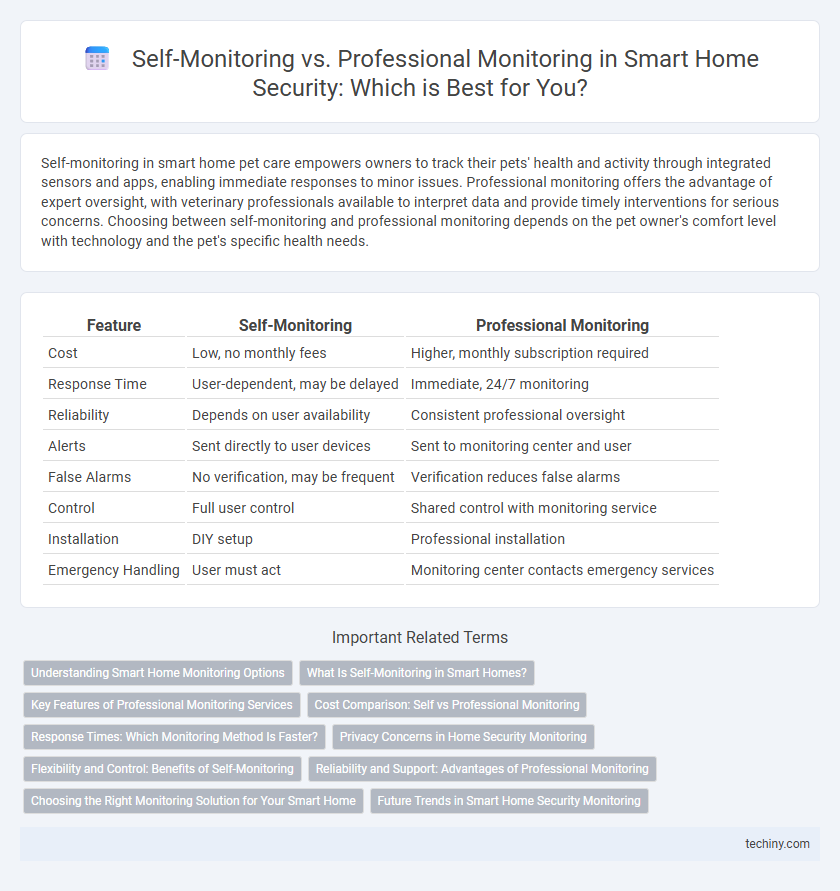Self-monitoring in smart home pet care empowers owners to track their pets' health and activity through integrated sensors and apps, enabling immediate responses to minor issues. Professional monitoring offers the advantage of expert oversight, with veterinary professionals available to interpret data and provide timely interventions for serious concerns. Choosing between self-monitoring and professional monitoring depends on the pet owner's comfort level with technology and the pet's specific health needs.
Table of Comparison
| Feature | Self-Monitoring | Professional Monitoring |
|---|---|---|
| Cost | Low, no monthly fees | Higher, monthly subscription required |
| Response Time | User-dependent, may be delayed | Immediate, 24/7 monitoring |
| Reliability | Depends on user availability | Consistent professional oversight |
| Alerts | Sent directly to user devices | Sent to monitoring center and user |
| False Alarms | No verification, may be frequent | Verification reduces false alarms |
| Control | Full user control | Shared control with monitoring service |
| Installation | DIY setup | Professional installation |
| Emergency Handling | User must act | Monitoring center contacts emergency services |
Understanding Smart Home Monitoring Options
Self-monitoring involves homeowners receiving real-time alerts through apps, allowing them to respond directly to security events, while professional monitoring provides 24/7 surveillance by trained personnel who can dispatch emergency services when needed. Smart home systems with self-monitoring often reduce monthly fees and offer greater user control, whereas professional monitoring enhances safety with constant oversight and rapid response. Understanding these options helps homeowners balance convenience, cost, and security based on their individual lifestyle and risk tolerance.
What Is Self-Monitoring in Smart Homes?
Self-monitoring in smart homes involves homeowners using connected devices like cameras, sensors, and alarms to independently track and manage security without relying on external services. This approach leverages smartphone apps for real-time alerts and control, enabling immediate responses to potential threats. Self-monitoring reduces monthly fees and offers personalized oversight, but it requires the homeowner's vigilance and prompt action to ensure safety.
Key Features of Professional Monitoring Services
Professional monitoring services in smart home systems provide 24/7 real-time surveillance by trained security experts who promptly respond to alarms and emergencies. These services often include automated alerts to emergency responders, comprehensive incident reporting, and integration with multiple smart devices for enhanced safety and convenience. Unlike self-monitoring, professional monitoring ensures immediate intervention during security breaches, reducing false alarms and increasing overall protection.
Cost Comparison: Self vs Professional Monitoring
Self-monitoring systems for smart homes typically incur lower upfront costs, ranging from $100 to $300 for equipment, with monthly fees between $0 and $15. Professional monitoring services often require higher initial investments, about $200 to $600 for equipment, and monthly fees averaging $30 to $60, reflecting ongoing expert supervision and emergency response. Choosing between self and professional monitoring depends on budget constraints and desired security reliability within smart home setups.
Response Times: Which Monitoring Method Is Faster?
Self-monitoring in smart homes offers instant alerts directly to homeowners, enabling immediate personal response, but relies heavily on individual availability and vigilance. Professional monitoring services provide 24/7 surveillance with trained operators who can quickly assess emergencies and dispatch authorities, often reducing response times significantly. Studies show professionally monitored systems average response times of 30 to 45 seconds, whereas self-monitoring response depends entirely on how quickly the homeowner receives and acts on alerts.
Privacy Concerns in Home Security Monitoring
Self-monitoring in smart home security allows homeowners to retain full control over their data, reducing risks related to third-party access and potential data breaches. In contrast, professional monitoring services store surveillance footage and personal information on external servers, raising concerns about data privacy and unauthorized use. Prioritizing encryption and transparent privacy policies is essential to mitigate privacy risks in both monitoring approaches.
Flexibility and Control: Benefits of Self-Monitoring
Self-monitoring offers unparalleled flexibility and control, allowing homeowners to customize alerts and responses according to their unique preferences and schedules. Real-time access to security data through smartphone apps ensures immediate awareness and decision-making without relying on third-party intervention. This autonomy reduces dependency on external services, potentially lowering costs while maintaining personalized protection for smart home systems.
Reliability and Support: Advantages of Professional Monitoring
Professional monitoring in smart homes offers unparalleled reliability through 24/7 surveillance by trained experts who promptly respond to emergencies, minimizing false alarms and ensuring timely intervention. This service provides continuous support with direct communication to emergency services, enhancing safety and peace of mind for homeowners. Unlike self-monitoring, professional systems reduce the risk of missed alerts due to user error or absence, delivering consistent protection and expert assistance.
Choosing the Right Monitoring Solution for Your Smart Home
Self-monitoring in smart homes offers direct control and cost savings by allowing homeowners to receive alerts and manage security through mobile apps, whereas professional monitoring provides 24/7 surveillance with rapid emergency response from trained personnel. Choosing the right monitoring solution depends on factors such as budget, desired level of security, and personal comfort with technology management. Integrating smart sensors, cameras, and automation systems enhances both monitoring types to protect your smart home effectively.
Future Trends in Smart Home Security Monitoring
Future trends in smart home security monitoring emphasize the integration of AI-driven analytics and real-time data processing to enhance both self-monitoring and professional monitoring systems. Advanced sensor networks and cloud-based platforms enable seamless communication between devices, allowing homeowners to customize security responses and maintain control while benefiting from professional oversight. The evolution toward hybrid models combines automated alerts with human verification, improving accuracy and reducing false alarms in smart home security solutions.
Self-Monitoring vs Professional Monitoring Infographic

 techiny.com
techiny.com